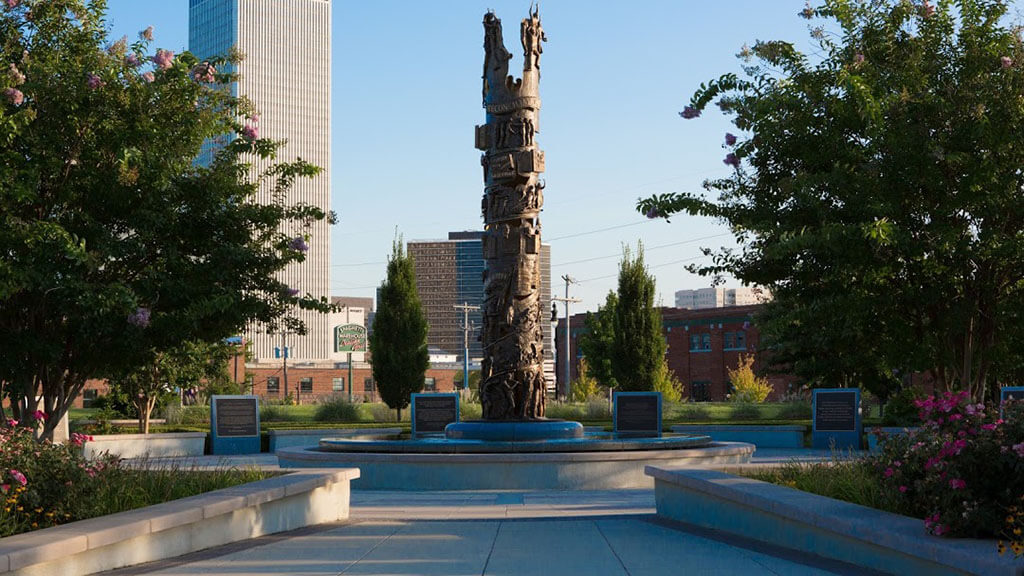HEATHER LEAH SMITH looks at ‘Black Wall Street’, the Tulsa Massacre, and ongoing economic inequality in the US
EXAMPLES of systemic racism abound in American history.
The National Institute of Health found white researchers to be twice as likely to win research grants than black researchers. A law review found that housing lenders have disproportionately steered black applicants towards subprime housing loans, even when qualified for prime rates. According to Brookings, comparable homes in black neighbourhoods are worth 23 percent less than in white ones. The Economic Policy Institute puts the median wealth of black college graduates at $23,400 — versus $180,500 for white graduates.
Median overall wealth for families also differs drastically by race, with black families at $11,030 versus white families at $134,230. So much for the present; a glimpse of the past is even more painful.
A century ago this week, members of the once prosperous black community of the Greenwood district in Tulsa were sifting through the ashes of destroyed homes and livelihoods. Around 10,000 people were left homeless after the infamous Tulsa Massacre, sparked by an alleged assault on a white woman by a black man. Many were sent to internment camps and forced to rebuild or relocate. The violence lasted less than two days — but the effects have lasted generations.

There are only 56 listings in the Tulsa directory of black-owned businesses as of June 2, 2021. There had been 191 before the massacre. The median income in the predominantly black part of North Tulsa is $29,000, compared with $60,000 in the largely white South Tulsa. A third of North Tulsa lives in poverty, compared with 13 percent in the South. Average life expectancy for black Tulsans is a decade shorter than their white counterparts.
Greenwood was like a city within the city, with its own hospital, library and post office in the 35-block district. There were several schools and churches. It had an upscale hotel, a theatre and many retailers, restaurants and professional service providers. Black business leaders accomplished all this within 60 years after the Civil War’s end — which seemed an affront to the white-dominated power structures of the day.
Property deeds and life savings were lost to looting and fires. Black community leaders were portrayed as the instigators of the “race riots”. Insurance companies targeted that nomenclature as justification to deny benefit claims, citing clauses that exempted them in cases involving racially motivated riots.
Somewhere between 100 and 300 people were killed, mostly African Americans. Over 1,200 black-owned homes were destroyed. According to a 2001 bipartisan commission report, the rioters caused a minimum of $1.5m in economic damage (about $22m in today’s terms).
The 2001 commission report held the city responsible for its complicity in the escalation of the violence, its failure to provide justice for the survivors and its suppression of truth. The report recommended paying reparations to survivors and their descendants, establishing a scholarship fund and revitalising the historic district as an economic development enterprise zone.
The city has raised some $30m for the centennial commission — but has been criticised for using most of those funds to build a historical centre called Greenwood Rising. No direct reparations were made to the community, no one was prosecuted and there has been no legislation or court order requiring compensation to be paid.
According to Harvard researchers, Tulsa’s black population experienced a 7.3 percent reduction in average incomes, accompanied by a decline in home ownership, occupational status and educational attainment. The socio-economic disruption and trauma caused by the massacre was passed down through the generations, a bitter inheritance.
University professors Chris Messer, Thomas Shriver and Alison Adams wrote about the eradication of Greenwood’s accumulated wealth: “The failure to provide reparations did not simply affect the direct victims of collective white violence. It was a part of a larger pattern that deprived later generations of African Americans of household assets and conveyed an implicit message that white violence would be either condoned or tolerated. That is the legacy that now demands a response.”
Economist Lisa Cook explored the relationship between violence and economic activity. “According to the historical literature, before 1921 potential victims implicitly believed that, if implored, the federal government would act,” she wrote. “The response to the Tulsa riot was considered a major policy shift in favour of non-intervention by federal and state governments.”
John Rogers Jr. is the founder and CEO of Ariel Investments, the country’s first black-owned mutual fund firm. He strives to narrow the wealth gap in the US — but warns that it’s worsening.
“As the proud great-grandson of JB Stradford, a pioneering entrepreneur who owned the Stradford Hotel in Tulsa, this is personal,” Rogers said. “His hotel was torched during the 1921 Tulsa race riots and the opportunity to pass down wealth through generations like many other white families went up in smoke. Imagine what the Stradford Hotel, or the Greenwood section of Tulsa known as Black Wall Street, would be like today.”
“Think about the billions of dollars in unrealised black wealth wiped out by angry mobs more than a century ago in Wilmington, North Carolina, or Memphis, Tennessee, the site of the Peoples Grocery,” Rogers said. “Add the weight of Jim Crow, red-lining and racism, and the root cause of economic inequality is clear.”




























